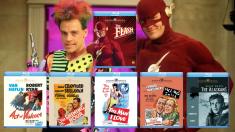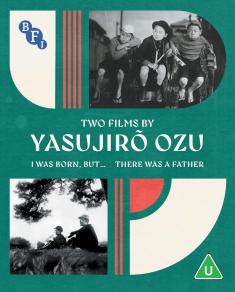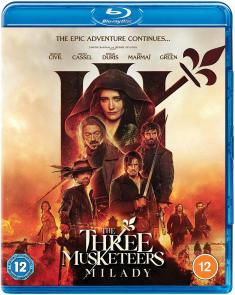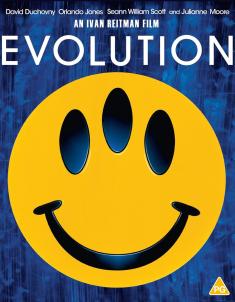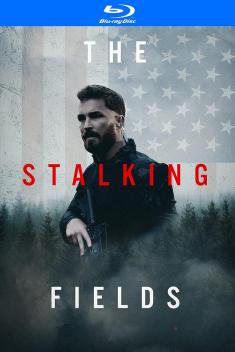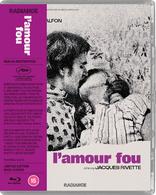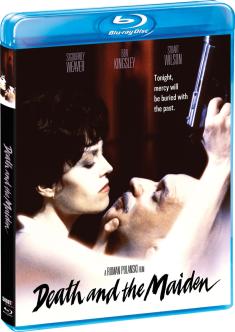Streets of Fire: Collector's Edition
Overview -
Amid a brooding rock & roll landscape, the Bombers motorcycle gang, led by the vicious Raven Shaddock (Willem Dafoe), kidnap diva Ellen Aim (Diane Lane). Her hope for rescue lies with unlikely heroes: soldier of fortune Tom Cody (Michael Pare) and his sidekick, the two-fisted beer-guzzling, McCoy (Amy Madigan). Joined by Ellen's manager, Billy Fish (Rick Moranis), the trio plunges headfirst into a world of rain-splattered streets, hot cars, and deadly assassins.
This cult hit features a razor-sharp cast and original songs written by Stevie Nicks, Tom Petty and Ry Cooder and performed by such greats as The Blasters and The Fixx. Streets of Fire is a rock & roll shotgun blast to the senses.
Storyline: Our Reviewer's Take
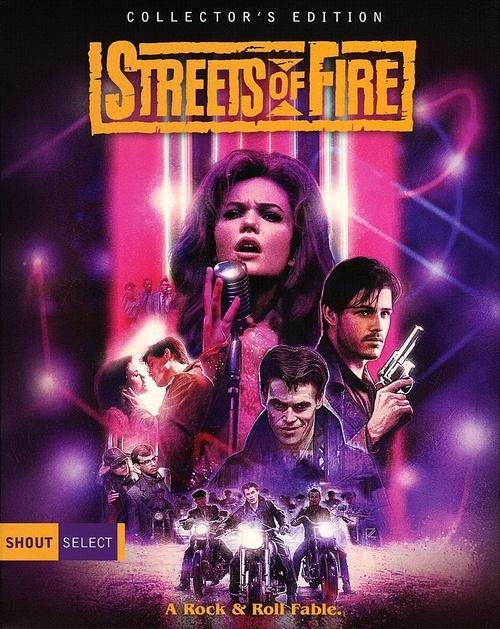
After the wild success of his buddy-cop blockbuster 48 Hrs., macho action movie director Walter Hill was a hot ticket in Hollywood and had his choice of any project he wanted to do next, the sooner the better. What he ultimately settled on was unexpected, even perplexing. The man responsible for violent, gritty movies about street gangs (The Warriors) and Old West outlaws (The Long Riders) wanted to make a musical – albeit one filtered through his own sensibilities. Coming from a major studio and the hands of an A-List filmmaker, a movie as ambitious yet idiosyncratic as Streets of Fire could not have been made at any time other than the early 1980s, but was perhaps always fated to go unappreciated in its day.
Described on-screen as "A Rock & Roll Fable" that takes place in a city identified only as "Another Time, Another Place," the movie opens with superstar rocker chick Ellen Aim (Diane Lane, only 19-years-old) abducted right off the stage by greaser gang leader Raven Shaddock (Willem Dafoe) while performing a benefit concert in her old slummy neighborhood of the Richmond District. When the ineffectual police are no use, Ellen's only hope for rescue comes from ex-boyfriend Tom Cody (Michael Paré), a tough guy mercenary coming straight off a stint in military service. Cody is a man of few words but many punches, and takes no guff from anybody.
Initially claiming to only be interested in a reward payout, Cody forms a small posse and treks through dangerous territory to the untamed outlaw zone known as The Battery, all the way on the other side of town a few hour's driving distance. Even after stealing the girl back (which happens barely 40 minutes in), Cody still has to contend with the vindictive Raven, who follows him home vowing revenge. Through all this, perhaps he and his former flame will even rediscover their feelings for each other.
Streets of Fire is a film of many conflicting ideas. Hill says that he wanted to make a light, comic book-style fantasy where none of the conflicts or fights would result in death, but then he filled it with plenty of visceral violence, profanity, implied rape threats, and even brief nudity inappropriate for younger viewers. It's a rock 'n roll musical with a main character modeled after '80s icons Joan Jett and Pat Benatar, placed in a 1950s B-movie plot blending elements of Westerns, film noir, rebellious youth biker pictures, and even a touch of ancient Greek myth (Ellen being a stand-in for the kidnapped Helen of Troy). For all this, the movie always knows exactly what it wants to be, even if critics and audiences in the summer of 1984 didn't.
If Walter Hill seems like the wrong director for material like this, he approaches it with a clear vision for a hyper-stylized fantasy world trapped somewhere out of time, where characters drive 1950s cars through a shadowy and neon-lit 1980s urban nightmare. As most classic Hollywood musicals had, he embraces the film as an artificial construct divorced from much resemblance to reality. A significant amount of the movie consists of nighttime exterior scenes shot on the Universal Studios backlot, and Hill went so far as to erect a gigantic $1.2 million tarpaulin covering the entire set so he could block out the sun and shoot during the day. (As you can imagine, that proved problematic when it rained, and when flocks of birds decided to nest under the tarp.) In a way, Streets of Fire is an amalgamation of all the movies Hill used to like when he was a youth, fused with the just-emerging MTV aesthetic of flashy colors, quick-cut editing, and pop music very much of its specific moment – all amped up to exaggerated levels and driven by Hill's own brand of muscular direction.

The narrative is admittedly pretty threadbare and simplistic, and has a fair amount of sexism built into its premise. (A scene where Cody punches Ellen doesn't seem as funny now as was probably intended.) Lead star Michael Paré is not a great actor. Although he has the tough-but-innocent look that Hill wanted and reads the lines as written, he lacks the charisma to sell them. The story also ends with an unsatisfying climax. These faults are forgivable if you're into everything else the movie is delivering, but may seem like major failings if you're not. On the other hand, Willem Dafoe makes a terrific villain. Diane Lane (already a veteran actress even at that age) was at her most achingly beautiful and does a pretty convincing job miming the song vocals.
The rockin' musical score was provided by Ry Cooder, who'd worked with Hill on two previous movies. The songs were mostly written by genuine music industry pros, including some big names like Tom Petty, Stevie Nicks and Bob Seger. The opening and closing anthems "Nowhere Fast" and "Tonight Is What It Means to Be Young" were penned by songwriter Jim Steinman, who composed Meat Loaf's "Bat Out of Hell" album, the influence of which is clear if you listen for it. All of the songs on the movie's soundtrack are perfect '80s pop confections. However, the only one to break out to mainstream success was "I Can Dream About You," which climbed the charts when performed by its original artist, Dan Hartman. (The version in the movie is sung by a fictional group with different vocals than the one that played on the radio.)
Honestly, I'm not sure that Streets of Fire ever really stood a chance at commercial success. The movie's a little too weird to be embraced by a typical multiplex audience. Unfortunately, by the time it was released to theaters, Universal Studios underwent a change in management, and the new regime decided to bury the picture by dumping it on the market with little promotion. Critics were confounded by it, and the movie was a box office bomb. Like many such passion projects made by strong-willed artists with unique visions, the movie eventually found a small cult of admirers on home video, and is still ripe for wider rediscovery. For a modern viewer, unfamiliarity with most of the songs in this musical may actually enhance the feeling of unearthing a hidden treasure of lost gems.

Streets of Fire was produced by Universal Studios, which released the film on DVD in 2001 and on the short-lived HD DVD format in 2007. Neither disc had any supplemental content. Over in the UK, a label called Second Sight put together a (Region B locked) Blu-ray in 2013 with a retrospective documentary and a handful of other bonus features. However, on domestic ground, Universal never bothered to bring the movie to Blu-ray until finally licensing it out to Shout! Factory for this new Collector's Edition that joins the Shout Select line as spine #15.
The Collector's Edition consists of two Blu-ray discs, one for just the movie and one for the extras. They come packaged in a keepcase and cardboard slipcover. As is standard practice for Shout!, the keepcase has a reversible insert, the backside of which is the movie's original theatrical poster art. This may be one of the few cases where I actually prefer the new art over the original.
Video Review
I was first introduced to Streets of Fire in the early 1990s, when Director of Photography Andrew Laszlo conducted a two-day seminar on cinematography at the film school I attended. As part of the presentation, he showed extensive clips from movies he'd worked on and, when it came to this one, told some fascinating stories about the production and the famous million-dollar tarp. Although the movie had been a box office failure, Laszlo was understandably proud of the work he'd done on it.
As I recall, the scenes we watched were projected from a Laserdisc source at the time. Even from that, I was dazzled by the visual style of the film. (In one of the documentaries on the Blu-ray, someone describes it as a "neon fever dream.") Sadly, as our home theater equipment and experience advanced over the years, Streets of Fire had never been done true justice. Universal's later DVD release was a non-anamorphic letterbox port from the Laserdisc (inexcusable in 2001). The HD DVD in 2007 was a new video transfer at that time and looked pretty decent overall, considering how poorly Universal treated most catalog titles, but was a little flat and overly-processed with Digital Noise Reduction. I haven't seen the UK Blu-ray from Second Sight but assume it shared the same master as the HD DVD.
For the Collector's Edition, Shout! Factory has struck a new video master based on a 2k scan of the film's interpositive. Before anyone balks at why the movie didn't get a 4k scan of the camera negative, the results here are actually quite gorgeous. The Blu-ray's 1080p/AVC MPEG-4 encode has an excellent sense of sharpness and detail, with a light (fully appropriate) veneer of film grain. That processed look from the HD DVD has been corrected. The contrast range of the 1.85:1 image is superb, from its inky blacks and sculpted shadows to car headlights piercing the darkness. Colors are also vivid and vibrant. The neon lights that illuminate most scenes and Diane Lane's deep red lipstick really pop off the screen.
The transfer's only serious detriment is some occasional light speckling on the film elements. Other than the opening credits, where white specks flitter over a black screen, I wasn't much bothered by this during the bulk of the movie. However, other viewers may be more sensitive to it. I'm sure that this could have been significantly reduced or eliminated with modern digital tools, and I'm disappointed that Shout! Factory didn't go to that effort.
Audio Review
Shout! Factory has provided the movie's soundtrack in 5.1 or 2.0 options, both encoded in lossless DTS-HD Master Audio format. I didn't detect very much surround activity difference in the scenes I compared, but the 2.0 seemed a little bit flatter so I defaulted to 5.1 when watching the movie straight through.
Obviously, as a musical, the fidelity of the music will be of top interest to most viewers. Both the background score by Ry Cooder and the numerous songs performed by on-screen characters sound very spacious and enveloping, but dynamic range is fairly limited with shallow bass. Other aspects of the soundtrack have strong separation of individual sounds, but also suffer a similar problem with dynamics. While motorcycle and car engine sounds are respectably growly, explosions are weak. How much of this is due to the age or budget of the movie, and how much to the 5.1 remix or disc authoring, I honestly can't say.
It's fine, and pretty satisfying on the whole. I just wished for a little more bass kick.
Special Features
The prior DVD and HD DVD from Universal offered no extra content at all. For the new Collector's Edition, Shout! Factory has licensed the features that first appeared on the UK Blu-ray from Second Sight.
- Rumble on the Lot: Walter Hill's Streets of Fire Revisited (HD, 82 min.) – Even without knowing its origin, I could immediately tell that this retrospective documentary was a few years old. Produced in 2013, the interview subjects such as director Walter Hill and star Michael Paré look noticeably younger than their appearance in Shout! Factory's own new documentary (see next section). The piece covers the expected making-of topics including the origin of the project, the casting, the visual design, and production stories about shooting on the Universal backlot. Much of this will seem redundant if you watch the other documentary first. Many of the same people tell many of the same stories in both. Exclusive to this one are interviews with costar Amy Madigan and a tribute to late cinematographer Andrew Laszlo.
- Vintage Featurettes (SD, 11 min.) – Straight from the movie's original Electronic Press Kit, five promotional clips hype the music, Walter Hill's "exaggerated realism," crowd choreography, the costumes, and the elaborate city street sets.
- Music Videos (SD, 15 min.) – Three vintage videos were edited together almost exclusively from movie clips and additional unused footage from the concert scenes. In all of them, the movie's cast lip sync over vocals from others artists. The songs are "I Can Dream About You" and two versions of "Tonight Is What It Means to Be Young" (one longer and in poorer condition than the other).
HD Bonus Content: Any Exclusive Goodies in There?
The following items make their debut with the Shout! Factory Collector's Edition:
- Shotguns & Six Strings: The Making of a Rock 'N Roll Fable (HD, 100 min.) – With a running time longer than the movie itself, Shout! Factory's newly-commissioned retrospective doc covers most of the same ground as the older piece from Second Sight. Blu-ray viewers who watch both back-to-back may find that frustrating, even if each is perfectly good individually. This one has new interviews with Walter Hill and Michael Paré, along with the film's screenwriter, producer, art director, editor, costume designer, and a few others. Sadly, neither Diane Lane nor Willem Dafoe appear in either documentary. The participants talk about the movie's development, influences, music, stunts, production troubles, reshoots and more. Notable revelations include that Tom Cruise was offered the lead role but passed to take another movie (based on production dates, possibly All the Right Moves), and that James Horner had initially composed a musical score that was rejected and replaced with Ry Cooder.
- Theatrical Trailer (HD, 3 min.) – Presented from film elements in really ratty condition, the vintage trailer quickly turns into a music video for the song "Nowhere Fast."
- On-Air Promos (SD, 13 min.) – There's little need to watch these extra clips from the movie's Electronic Press Kit if you've already watched the two documentaries, because all of them were already incorporated into those.
- Still Gallery (HD, 10 min.) – The montage of production stills and behind-the-scenes photos doesn't contain much exciting, though the glamour shots of young Diane Lane are enjoyable to watch.
Made right at the cusp of the MTV era, Walter Hill's rock musical Streets of Fire was both a movie of its moment and one ahead of its time. Even though it failed to find an audience in 1984, it's the type of film that begs for (and deserves) cult acclaim.
The Collector's Edition from Shout! Factory is a splendid Blu-ray with a gorgeous video transfer and a couple of very thorough documentaries. Any fan of the film will be thrilled to own it.




